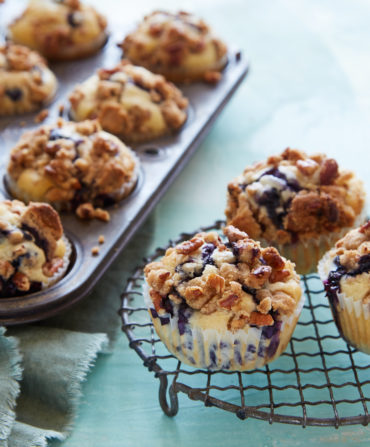It’s been called “the Mother sauce of the South,” “the duct tape of Southern cooking,” and “the quintessential Southern condiment.” But for Ashley Strickland Freeman, a Charleston, South Carolina–based recipe developer, Duke’s mayonnaise is all that and more—it’s also her secret ingredient and obsession. Over the past three years, Freeman, the food stylist for Food Network’s Delicious Miss Brown, has gone through forty-eight pounds of the special sauce—putting it in everything from chocolate cake to hot chicken to green tomato pie—to craft her mayo opus: The Duke’s Mayonnaise Cookbook: 75 Recipes Celebrating the Perfect Condiment. On June 30, exactly 103 years after Greenville, South Carolina’s Eugenia Duke set mouths to watering with the creation of the homemade condiment, Freeman’s 240-page spread on the spread will be released.
So, why Duke’s? The cult classic Southern brand has played an integral part in Freeman’s life since her childhood in Savannah, Georgia. “It was the only mayo we ever used,” she says. Not only was Duke’s always stocked in the family’s pantry and a staple at the bed and breakfast her parents then owned, the Hamilton-Turner Inn, it was also her mom’s preferred storage receptacle. Rather than keeping baking soda and sugar in Tupperware, Freeman’s mother opted to store them in old glass Duke’s jars (discontinued for plastic in 2005), which she still uses to this day.

“Duke’s is one of those things that you don’t really appreciate until it’s not there,” Freeman says. She learned that the hard way: After moving to New York City to attend the French Culinary Institute following her graduation from the University of Georgia in 2004, the Southerner was shocked to discover her beloved mayo hadn’t made it above the Mason-Dixon Line. “I was like, ‘What’s up with this?’” she recalls.
That’s not the case today, of course. Duke’s, now owned by the Charlotte, North Carolina–based equity firm Falfurrias Capital Partners, is distributed across the country, but it’s most loyal following remains strongly rooted in the South, where the fanaticism began during World War I. That’s when Eugenia Duke, an enterprising housewife looking to help support her family, began a sandwich-making business out of her kitchen. Her egg salad, pimento cheese, and chicken salad sandwiches—all built on the foundation of her signature mayo—took off quickly with Dough Boys at nearby Camp Sevier. By 1919 she was selling 10,000 sandwiches a day, wrote Emily Wallace in a 2013 Washington Post article; Wallace, a food historian, is also, incidentally, the illustrator of Freeman’s new cookbook.
RECIPE FROM THE BOOK: GREEN TOMATO PIE
As Wallace described in that 2013 story, Duke’s appeal has only increased through the years and inspired all manner of tributes, from paintings to jewelry to tattoos to even…internments. According to Wallace, an elderly woman once wrote the company requesting three of those discontinued Duke’s glass jars so that her cremated ashes could be divvied up among her three daughters and laid to rest. Naturally, Duke’s honored her final request.
Brand loyalty that extends to the afterlife? That’s something other mayos can only dream of. Here, Freeman shares what she thinks makes Duke’s so irresistible.
In a world where many chefs stake their reputations on making everything from scratch, Duke’s defies the odds as a staple in many Southern restaurant kitchens. How come?
It has a cult following. People are obsessed with the stuff. The lack of sugar makes it more versatile and it tastes more homemade. I quote the chef Kevin Gillespie (the owner of Atlanta’s Gunshow and Revival) in the book, and he says when he lived out west for a while, he would have his mom ship him cases of Duke’s because he couldn’t get it out there.
The most typical Duke’s application is on sandwiches. In your cookbook, however, you put it in a range of dishes, from cottage pie to blueberry streusel muffins. Why does it work for both?
For me, mayonnaise is a secret weapon in baking because it adds moisture. It’s also salty, and we often use salt to bring out flavors in a recipe. That little extra flavor helps the other ingredients sing. That’s why it works in both savory and sweet applications.

RECIPE FROM THE BOOK: BLUEBERRY STREUSEL MUFFINS
Do you have a favorite recipe? What about your four-year-old son, Anderson?
My banana bread recipe is killer. And the firecracker shrimp tacos, I could eat those every day. Anderson inspired so many recipes in the book since he’s such a helper in the kitchen. We make the bananas Foster bread a lot, and he really loves the churro waffles. I also love the triple chocolate mousse cake. It’s a showstopper.
You say in the book that mayo helps give the cake a more tender crumb.
That’s right. Using mayonnaise in cake batter is said to date back to the Depression, when certain ingredients were scarce. What was intended to be a way to make do with what you had turned out to be a game changer for baking. Think of what mayonnaise is: oil, egg yolks, and acid (vinegar or lemon juice). The oil makes the crumb tender, the extra fat from the egg yolk makes the cake moist, and the acid pumps up the flavor.
RECIPE FROM THE BOOK: TRIPLE CHOCOLATE MOUSSE CAKE
Do you think the cake is good enough to change anti-mayo peoples’ minds?
My goal with this book is to turn mayo haters into mayo lovers.
Are you sick of Duke’s yet?
Let me put it this way, we started the quarantine with four jars of Duke’s. Now we’re down to one.








